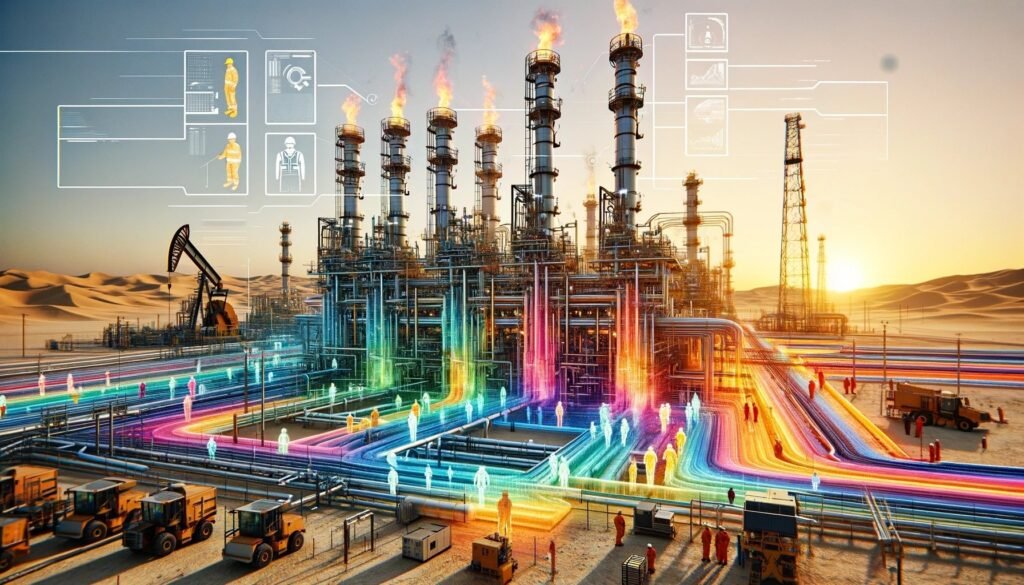Physical Address
304 North Cardinal St.
Dorchester Center, MA 02124

The oil and gas industry has always been shaped by technology from the earliest seismic surveys to advanced offshore platforms. Today, however, the industry is undergoing a digital revolution powered by Artificial Intelligence (AI) and Big Data analytics.
These technologies are redefining oil exploration and drilling, making operations smarter, safer, and more efficient.

Shell uses AI in seismic imaging, improving reservoir mapping accuracy by up to 30%. ExxonMobil leverages AI-driven analytics for predictive maintenance across offshore rigs. Equinor has deployed machine learning models to optimize well placement in the North Sea, increasing production efficiency. These examples show how industry leaders are moving from pilot projects to large-scale AI adoption.
For decades, exploration was driven by seismic imaging, geological surveys, and human expertise. While these methods remain vital, the amount of data generated by modern exploration from seismic readings to drilling sensors has grown exponentially.
Traditional methods cannot keep up with the sheer volume, velocity, and variety of this information. That’s where AI and Big Data come in.
Big Data allows operators to collect, store, and process vast amounts of geological, operational, and production data.
AI algorithms transform this data into actionable insights, predicting drilling outcomes and optimizing exploration strategies.
According to McKinsey, digital technologies, including AI and data analytics, could deliver $50 billion to $100 billion in annual savings across the industry.
Europe’s gas crisis accelerated reforms in its energy markets:
Joint Gas Purchasing: The EU launched a platform to pool demand and negotiate better deals (European Commission).
Strategic Storage: Mandatory storage targets ensured facilities were filled before winter.
Interconnections: Cross-border pipelines and reverse flow capacity made energy flows more flexible.
Together, these measures created a more resilient energy system.
Big Data transforms how oil companies manage resources:
Real-time monitoring of drilling operations improves safety.
Integrated data platforms combine geological, seismic, and operational data into a single decision-making framework.
Optimization algorithms improve well placement and enhance recovery rates.
For instance, BP has developed “Digital Twins” virtual replicas of physical assets to optimize performance and reduce downtime.
Reduced Costs: AI lowers exploration costs by cutting interpretation time and reducing dry wells.
Improved Safety: Predictive analytics reduce risks of accidents and environmental hazards.
Higher Recovery Rates: Smarter drilling means extracting more oil from existing fields.
Faster Decisions: AI-driven dashboards allow executives to make data-backed decisions in real time.
Despite its promise, digital transformation in oil exploration is not without challenges:
Data Quality: Poor or incomplete data reduces the accuracy of AI models.
Cybersecurity: Digital oilfields are vulnerable to cyberattacks targeting critical infrastructure.
Workforce Skills Gap: Integrating AI requires training petroleum engineers in data science.
High Initial Costs: Developing AI and Big Data infrastructure can be capital-intensive.
Looking ahead, AI and Big Data will only grow in importance. Emerging trends include:
Autonomous drilling rigs powered by real-time AI analytics.
Quantum computing to process seismic data faster than ever.
Greater integration of renewables and fossil fuel data to balance portfolios.
According to Deloitte, companies that embrace digitalization now will be best positioned to thrive in a low-carbon but data-driven energy future.
The oil industry’s reliance on AI and Big Data signals a new era of smarter drilling. By enabling faster exploration, reducing risks, and cutting costs, these technologies ensure that oil companies remain competitive in an evolving energy landscape.
For an industry that has always depended on innovation, the digital revolution is not just an upgrade, it is a transformation.

Seismic surveys generate massive data volumes. Traditionally, geologists spent months analyzing wave patterns to identify potential reservoirs.
AI-driven seismic interpretation uses machine learning to recognize subsurface structures quickly and with greater accuracy, reducing exploration time.
AI models trained on historical drilling data can forecast pressure levels, rock formations, and potential hazards. This reduces the risk of blowouts or drilling failures.
Reservoir simulations once took weeks to compute. AI accelerates this process, updating models in real time as new drilling data arrives.
Predictive maintenance powered by AI sensors monitors drilling rigs and pipelines, identifying wear and tear before costly breakdowns occur.

While AI makes oil exploration more efficient, it also plays a role in the energy transition:
Optimizing natural gas operations to replace coal in power generation.
Reducing carbon emissions through carbon capture and storage (CCS) optimization.
Helping companies integrate renewable energy into operations.
The same AI tools that optimize drilling are also being applied to wind, solar, and hydrogen projects suggesting a future where oil majors become energy majors.





